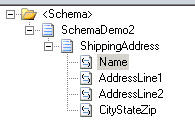
- BIZTALK XPATH FOR ATTRIBUTE VALUE HOW TO
- BIZTALK XPATH FOR ATTRIBUTE VALUE UPDATE
- BIZTALK XPATH FOR ATTRIBUTE VALUE FULL
- BIZTALK XPATH FOR ATTRIBUTE VALUE CODE
- BIZTALK XPATH FOR ATTRIBUTE VALUE ZIP
The only time this shortening would get you in trouble is if you had the same element under more than one namespace.
BIZTALK XPATH FOR ATTRIBUTE VALUE FULL
In other words, the longer full syntax is often shortened to this: If you have the same namespace all the way through your schema, then you can leave off the namespace-uri() predicate. local-name() and namespace-uri() are functions (or internal variables?) that return the current element name and the current namespace). It selects all element children of the context node.īut then we don’t really want all the nodes, so we apply the predicate or “where clause” – only give me the nodes where the local-name()=’SchemaDemo2′ and namespace-uri()=’′ (and that must be enclosed in brackets). The “*” is the abbreviation for the “child” axis (explained more here:, , ). The / is the normal separator, and starting point from the current node.

So when you see the typical Microsoft generated XPath, it can be explained as follows. Even in SQL terminology, a predicate is something that results in a TRUE or FALSE. So think of a predicate as a “Where Clause”. In the table below we have listed some path expressions with predicates and the result of the expressions:Īnd here are the example they give, but no examples with namespaces! Predicates are always embedded in square brackets. Predicates are used to find a specific node or a node that contains a specific value.
BIZTALK XPATH FOR ATTRIBUTE VALUE CODE
On this xpath syntax page, it does however define a predicate which is the XPath code in between the square brackes. What does the above actually mean? W3Schools has a good tutorial on XPath, but it doesn’t cover dealing with namespaces. If you click on the “Name” element, then go to the properties window, you will see the following Xpath in the value of the field called “Property XPath”. Example 1įor example, look at the schema below.
BIZTALK XPATH FOR ATTRIBUTE VALUE ZIP
PowerShell to build AWS Lambda Zip for Upload February 5, 2021.Access denied \AppData\Local\Temp\PID# does not appear to be a BizTalk Assembly February 9, 2021.BizTalk – Send Dynamic File from Orchestration May 19, 2021.
BIZTALK XPATH FOR ATTRIBUTE VALUE HOW TO
BIZTALK XPATH FOR ATTRIBUTE VALUE UPDATE
Inner exception: Illegal attempt to update the value of part ‘part’ in XLANG/s message ‘msgCanonical’ after the message construction was complete. NOTE: A few months after writing this post, I copied the above into a different message assignment shape, and got this error: “ Inner exception: Expression must evaluate to a node-set” – I think this happens if you put the String statement on the left side of the assignment statement. Only text-only elements or attributes may be selected”. “selected a node which is not valid for property or distinguished field retrieval, or it selected no node at all.

Xpath(msgCanonical, strXPATH) = strFileRcvdName ġ) If you leave off the /text() statement, you might get this error: In this case, I only had one MESSAGE_HEADER child, but I still had to specify the subscript of. I then had to add the subscript, which is needed if you have an element that has “Max Occurs=UNBOUNDED”. I like to put the xpath in a string variable. You can copy/paste the XPATH from the properties box on a schema or map (after clicking on the element or attribute). It is used to convert a “node” to a string value. The “String” function, is used only the right side of the assignment statement.

Seems like that page might have a mistake, is says “select the fourth book element”, but shows xpath of “/catalog/book”.Ģ) It doesn’t show a good example of how to set an XML element value. There are two problems with that page.ġ) Xpath subscripts ared 1-based and not 0-based. This is the MSDN page for the BizTalk XPath statement. the left side of an equation or the equal sign)? I’m referring to a message assignment shape, in an orchestration, where you want How do you use the XPath statement on the left side of an assignment statement (i.e.


 0 kommentar(er)
0 kommentar(er)
